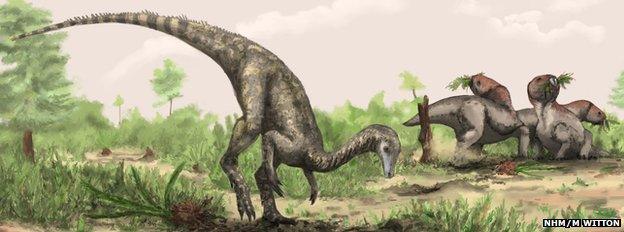New contender for oldest dinosaur
- Published

Nyasasaurus parringtoni would have shared the land with silesaurs, identified as dinosaurs' closest relatives
Palaeontologists have found what is likely to be the oldest known dinosaur, filling in a yawning evolutionary gap.
A study in Biology Letters, external describes Nyasasaurus parringtoni, a new species from 10-15 million years before the previous earliest dinosaur specimens.
It walked on two legs, measured 2-3m in length with a large tail and weighed between 20 and 60kg.
The find suggests that many millions of years passed between dinosaurs' first members and their dominance on land.
"It fills a gap between what we previously knew to be the oldest dinosaurs and their other closest relatives," report co-author Paul Barrett, of the Natural History Museum in London, told BBC News.

The find shores up the idea that dinosaurs evolved on the southern parts of the supercontinent Pangaea
"There was this big gap in the fossil record where dinosaurs should've been present and this fossil neatly fills that gap."
However, the team behind the work has stopped short of definitively calling N parringtoni the earliest dinosaur, because the fossil skeletons used to define it were incomplete: one upper arm bone and six vertebrae.
The early evolution of dinosaurs is difficult to unpick, as a rich variety of reptiles were proliferating at the time - and some may even have independently evolved characteristics that are associated with dinosaurs.
The researchers, from the University of Washington and University of California Berkeley in the US and the Natural History Museum, re-examined a number of bones that were first collected from what is now Lake Malawi in southern Africa.
They saw a few features that are unambiguously those of dinosaurs - notably what is called an "elongated deltopectoral crest" that served as an anchor for strong pectoral muscles.
Lead author of the research Sterling Nesbitt, of the University of Washington Seattle, led a team that in 2010 reported the finding of dinosaurs' oldest relative, external, a member of a group called the silesaurs.
It now appears that those creatures shared the southern part of the supercontinent Pangaea - now South America, Africa, Antarctica and Australia - with N parringtoni.
"Those animals were the earliest of this group that led up toward dinosaurs," explained Dr Barrett. "Now this takes dinosaurs back to the right kind of time when those two groups would have split apart from each other."
As it closes that evolutionary gap, it shows that dinosaurs did not start out as dominant as they later became.
"We push the origin of dinosaurs further back in time to a time when lots of reptile groups are evolving," Dr Barrett said.
"Dinosaurs start out as a very insignificant group of reptiles - all relatively small animals, relatively rare in comparison with other reptile groups - and it's only a bit later in their history that they suddenly explode and take over as the dominant forms of life for nearly 100 million years."
- Published24 January 2012
- Published12 November 2010